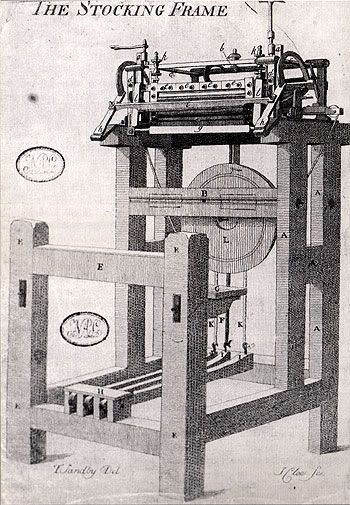The history of Industrial Automation, although it surely results from centuries of ideas, inventions and applications, has its definite beginning in Industrial Revolution England. Two centuries before the beginning of the Revolution, however, in the same Country, and in the very same field which gave a start to the Revolution itself - that of the textile Industry - a machine appeared which clearly foreshadowed the direction Industry was going to take: William Lee's Stocking Frame.
Knitted hoses and stockings - of course made by hand - were an essential piece of clothing in Tudor England, between 1500 and 1600. Men wore them of course, but so did women as well, under the long skirts in use at the time - an enormous market, where the manufacture of a pair of woolen stockings, hand-knit, took around four working days.
This is where William Lee, curate of the small town of Calverton, in England, comes onto the scene. According to legend, to free a girl he was courting from the massive hand-knitting work which took all of her time, more likely foreseeing the economic possibilities in the market, Lee developed, step by step, a machine which exactly imitated the knitters' hand-movements, but at extraordinarily improved speed - in the end, up to twelve times faster. The Stocking Frame could manufacture enormous quantities of woollen stockings, and later, silken stockings as well - but paradoxically, this was the very reason which brought Queen Elizabeth the 1st to deny Lee a patent. The interests of the thousands of english Knitters and their Guilds would be severely endangered by a machine which could work so much faster, and the times, clearly, were not yet right. Lee had better fortune in France, where he subsequently moved, and managed to obtain a patent: unfortunately, though, his ambitions, and new factory in Rouen, were quashed by the growingly hostile local climate towards his nationality and religion. Lee died, in great distress, in Paris, in 1614.
Despite his misfortune, William Lee thus stands, with his Stocking Frame, as one of the immediate precursors of that world-shaking event that was the Industrial Revolution - the event from which much of our modern world stemmed, surely including our work with Automation. The hooked shape of the needles in his machine is still identical today, four centuries later, in modern knitting machines; and so is his guiding principle of inventing, and constantly improving, machines such as those which move our Industry, every day.
Knitted hoses and stockings - of course made by hand - were an essential piece of clothing in Tudor England, between 1500 and 1600. Men wore them of course, but so did women as well, under the long skirts in use at the time - an enormous market, where the manufacture of a pair of woolen stockings, hand-knit, took around four working days.
This is where William Lee, curate of the small town of Calverton, in England, comes onto the scene. According to legend, to free a girl he was courting from the massive hand-knitting work which took all of her time, more likely foreseeing the economic possibilities in the market, Lee developed, step by step, a machine which exactly imitated the knitters' hand-movements, but at extraordinarily improved speed - in the end, up to twelve times faster. The Stocking Frame could manufacture enormous quantities of woollen stockings, and later, silken stockings as well - but paradoxically, this was the very reason which brought Queen Elizabeth the 1st to deny Lee a patent. The interests of the thousands of english Knitters and their Guilds would be severely endangered by a machine which could work so much faster, and the times, clearly, were not yet right. Lee had better fortune in France, where he subsequently moved, and managed to obtain a patent: unfortunately, though, his ambitions, and new factory in Rouen, were quashed by the growingly hostile local climate towards his nationality and religion. Lee died, in great distress, in Paris, in 1614.
Despite his misfortune, William Lee thus stands, with his Stocking Frame, as one of the immediate precursors of that world-shaking event that was the Industrial Revolution - the event from which much of our modern world stemmed, surely including our work with Automation. The hooked shape of the needles in his machine is still identical today, four centuries later, in modern knitting machines; and so is his guiding principle of inventing, and constantly improving, machines such as those which move our Industry, every day.


